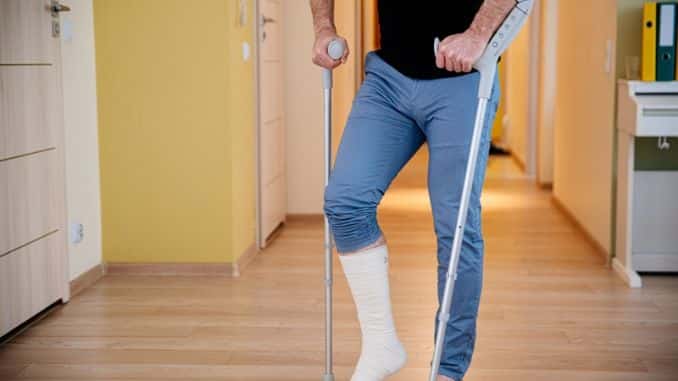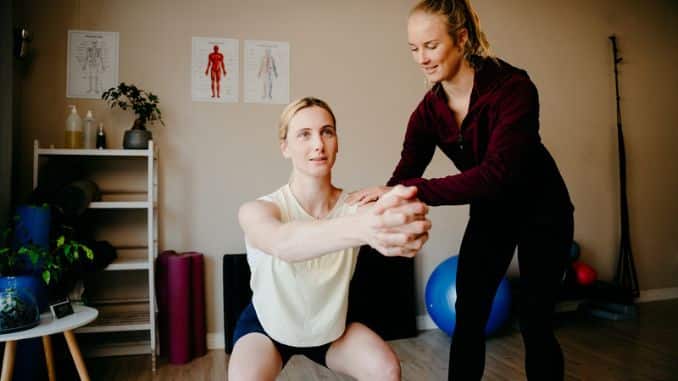
Today, I am coming to you from San Diego with an article from Kyla Gagnon. Kyla is a fellow Canadian and does a lot of bodyweight training. The last time I was here in May, I ran into Kyla at a fitness mastermind meeting. Her take on how bodyweight exercises can help you with your injury.
Enjoy.
Rick
Here is a simple fact. Injuries suck.
If you’ve injured yourself, you might immediately feel a great deal of frustration. And anger set in as you know this may mean time away from your training.
Nothing is more devastating to someone serious about their results than finding themselves injured and unable to keep at it.
Hi, I’m Kyla Gagnon, a certified personal trainer, nutrition expert, and Professional Bikini Model. Make no mistake about it; just like you, I have had some injuries which have set me back.
What’s even worse is often, the most serious injuries and pain that occur could have easily been prevented.
Getting injured ridiculously. It can leave you frustrated. How about popping out a rib, reaching up for a towel, or your back when you brush your teeth? But not only that, you will be frustrated and suffer from rib and back pain.
Please, how does this even happen?
You end up thinking if you had only just been more aware of yourself. While going about your exercises or daily living, you could have avoided the injury altogether.
But, before you hang up your gym shoes, take a week or two off. Allow the healing process to get underway. You may want to consider the possibility of utilizing bodyweight exercises. To help not only maintain your fitness while you are taking time away from heavy lifting. But also to strengthen some of the muscles and ligaments surrounding that injury.
Or perhaps you suffer from a chronic ailment such as a herniated disc or other back pain. And you have decided to move to bodyweight training as your primary source of fitness and lean muscle development.
Let’s have a quick look at a few key points you should remember when thinking about using bodyweight exercises to combat an injury.
How Bodyweight Exercises Can Help Your Injuries
Let’s talk about why bodyweight exercises can help when dealing with an injury or if you have rehabbed and want to avoid an injury.
Often it’s the sheer stress load of such a heavyweight that further aggravates the injury, making it much harder to heal yourself and recover.
If you keep pushing, you will further break down the injured tissues, continuing the inflammation and aggravating the injury.
But, with bodyweight training such as the BodyRipped Totality system, you’ll only have to support your body weight, which is more than sufficient to maintain muscular strength while the healing process gets underway. Bodyweight training won’t put as much strain on the body, and blood will continue circulating through the injured area.
In addition, bodyweight exercises will typically require balance and agility as you perform them, especially as you advance from the beginning momentum phase to the advanced perform phase of the Totality system. It will help build up the muscle fibers deep within the muscle tissues and the ligaments and tendons.
This, in turn, makes you stronger, and even if you have recovered from the injury and get back to your regular training, you’re less likely to find yourself injured again.
Which Bodyweight Exercises To Perform?
Bodyweight exercises can help you through an injury such as back pain and, more importantly, your rehab and future training regime, but which bodyweight exercises should you perform?
First, you need to assess the nature of your rehab, for back pain, as an example, and future training plans and goals. In some cases, an injury will be just to a small muscle group and be more of a nagging pain than anything else. In this case, it’s not going to be all that limiting, and you’ll have the freedom to move through your desired program. Even when injured, you might be surprised to learn that you can perform at a high level while protecting the injured area. Maintaining mobility, with the guidance of a practitioner, is critical for your rehab and future fitness.
One of the most challenging injured areas is your back, especially if you suffer from chronic back pain. Maintaining mobility will be integral to speeding up your recovery when you are recovering and trying to fix your back pain. Integrating bodyweight training is one of the solutions for recovering from a back injury.
If the injury is more severe and does lead you to experience sheer pain, you may need to avoid exercises that call those muscle groups into action. In these instances, any stress may be too much for the muscle group, so you’ll need to focus on bodyweight exercises that challenge other areas of the body instead, allowing that injured area to get straight rest.
8 Good Bodyweight Exercises :
- air squats
- lunges
- split squats
- single leg squats
- sumo squats
- step-ups
- pull-ups (wide grip, narrow grip, reverse grip), push-ups (regular, decline, inline, triangle)
- along with dips
You can also consider including plyometric exercises in your workout if you aren’t injured in the lower body. These exercises are great for maintaining strength and will also help enhance your power capabilities.
These include movements such as jump squats, lunges, or box jumps.
Just keep in mind that plyometric exercises are more taxing to the body. So these are typically best saved when the injury only impacts the upper body area. Injury is one of the primary reasons people fail to stay fit. Often because they go back to their old habits. And re-injure themselves, and sometimes it is even worse than the first occurrence.
It can be avoided by using a bodyweight training system such as BodyRipped Totality A2X as your foundation.
Important Points To Remember
However, whether you are rehabbing or have chosen to change to a bodyweight workout regime, perhaps due to some chronic injury, know this bodyweight training is a powerful way to go.
If you experience pain at any point throughout the session, stop immediately and back off to rest. Please listen to your body.
So there you have some key points to remember. If you do find yourself injured and the thought of taking time away from your training is making you shudder. You have a powerful solution available to you. This is a great time to transition to one of the most effective methods of training supported by science.
If it’s asking you to rest, do so; otherwise. You may be dealing with this injury for longer than you intended. If you can train through it, start your new fit and healthy body using bodyweight exercises.
Kyla Gagnon
If you want more details on Bodyweight Workouts, you can check it out here.




